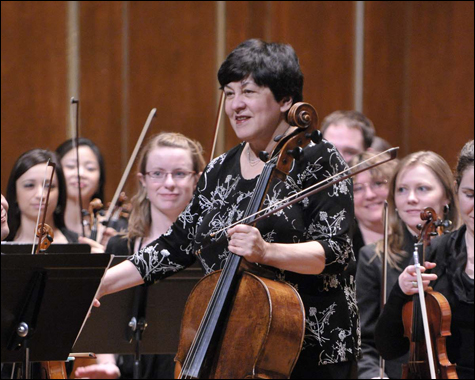Benjamin Zander and the Boston Philharmonic Orchestra at Sanders Theatre, February 24, 2008

Natalia Gutman
|
Four was the number that bound the two Russian pieces on the program that Benjamin Zander and the Boston Philharmonic presented this past weekend at NEC’s Jordan Hall and Harvard’s Sanders Theatre: Shostakovich’s Cello Concerto No. 1 and Tchaikovsky’s Symphony No. 6, the Pathétique. Four movements in each, and each built, often ingeniously, on four notes. And Tchaikovsky died four days after contracting cholera, just nine days after the Pathétique’s premiere. Both composers are also on the run, Shostakovich from the post-Stalinist Soviet Union of the 1950s (he composed this concerto in 1959, in the wake of Boris Pasternak’s being awarded the Nobel Prize for Dr. Zhivago), Tchaikovsky from a society that did not accept, at least not openly, homosexuals. The concerto is a hare fleeing the Soviet hounds, Eliza crossing the ice with Simon Legree in hot pursuit. The symphony is a sensibility in literal decline, its scales endlessly descending Piranesi staircases, its stars going out one by one.
For the Shostakovich, Zander had snagged the legendary Russian cellist Natalia Gutman. She talks like a legend — “Not too slow — Shostakovich said this” was her response to one passage in rehearsal — and she plays like one, throttling her instrument and daring orchestra, conductor, and audience to imagine that the music could go any other way. Sunday afternoon it was all straightforward, intense, powerful but never ugly, a kind of urban Stravinsky, cut off from Russia’s history but not from Russia’s folkish lilt, creating a sardonic Mahlerian dance as it thumbed its nose at the authorities. The second movement was a dreamy lullaby/lament à la Akhmatova or Tsvetaeva that glowed like the Comet of 1812 over Moscow and shimmered like Ives’s The Unanswered Question; the violins have a hint of the introduction to Mahler’s second Das Lied von der Erde song, “Der Einsame im Herbst,” going wrong. Time — or the orchestra — froze for the third-movement cadenza, for unaccompanied cello, with its fierce plucking and rising agitation that runs smack into the orchestra starting the fourth movement. Smack into the arms of Khrushchev’s minions? No, more like finding a safe house, Gutman a perpetual-motion machine and everybody dancing with the Devil, those four notes emerging triumphant.
Tchaikovsky’s four notes, three rising and one falling back, never for a moment suggest they’re going to triumph. It was painful to see — and hear — Zander’s violins massed on his left, in the traditional 20th-century phalanx formation, rather than in the antiphonal deployment that Tchaikovsky wrote for and that James Levine has brought to the BSO. (Zander does divide his violins in his Telarc Mahler cycle with the Philharmonia of London.) This was nonetheless a cogent reading, fervent rather than weighty, folk-like and dance-like where appropriate, without hysteria and without the fainting couch. The strings in the march were unstrident, suggesting a Mendelssohnian scherzo; the brass at the end of this nightmare-victory movement, Tchaikovsky’s most perverse and puzzling, brought out the hint of Offenbachian cancan. Played at what sounded like Tchaikovsky’s marked crotchet of 80, the difficult Andante mosso processional that ends the first movement didn’t conjure the loss, the irrevocability, of The Cherry Orchard (that’s why it’s difficult), and the Andante finale, Swan Lake without the B-major apotheosis, also lacked a degree of closure. But Zander balanced the pathos and the passion here the way you have to balance the rose and the distaff/thorn in The Sleeping Beauty, and that was no small thing.